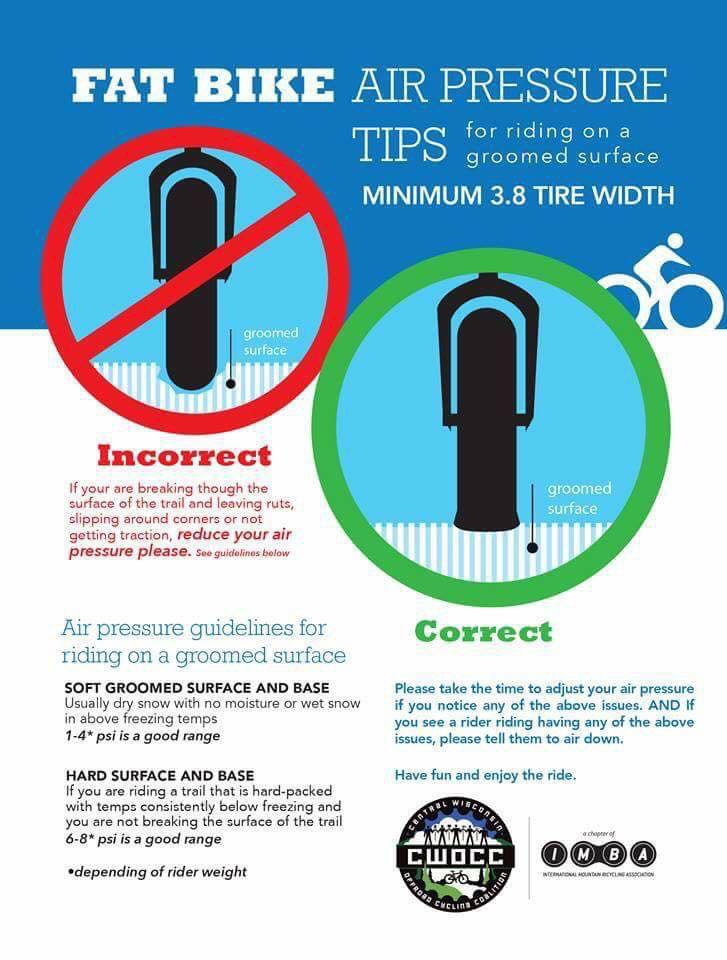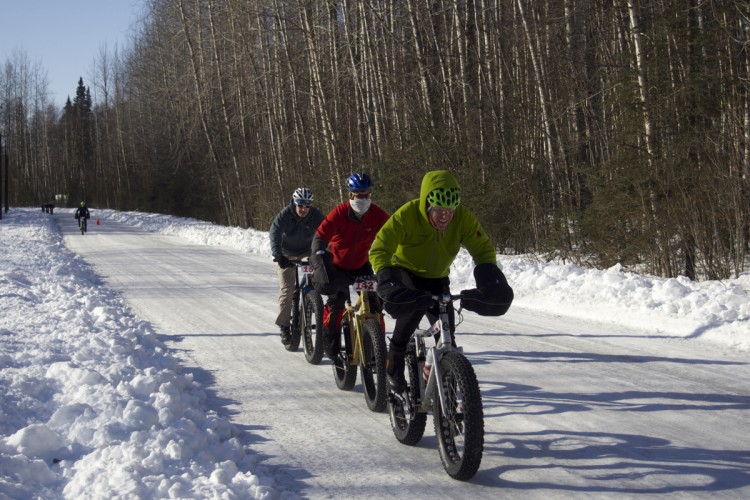
While it’s now common knowledge that riding wet singletrack trails and leaving a rut behind is poor form and destroys the trails, once the snow falls and the trails are covered, they’re totally protected, right?
Not so fast.
Mountain bike clubs in many areas of the country are now grooming singletrack trails for fat biking. While the advent of the fat-tired bike and bike trail grooming has virtually irradicated the mountain biking off-season in many parts of the country, grooming snow is a time-consuming and costly endeavor. Not only is the grooming equipment expensive to buy (or fabricate) and maintain, the amount of time required to keep the snow singletrack (known as “fattrack”) groomed and rideable is significant–especially in areas that receive regular snowfall.

While some intrepid clubs organize a team of volunteer labor, many clubs and land managers have resorted to paying an hourly wage to groomers. Some ski resorts (like Grand Targhee) are known to have an extensive and well-maintained fat bike network, and this is largely due to their ability to pay for the grooming labor.
Since grooming snow is time-consuming or costly (or both), it’s of paramount importance to respect the effort that goes into that grooming. Here are some tips for fat biking respectfully.

Fat Bike Etiquette
I’ll begin by considering groomed fattrack with these fat bike etiquette tips, and then will move on to other types of trails.
1. If you’re leaving a rut, turn around
If there’s one cardinal rule of fat biking on groomed fattrack, it’s “don’t leave ruts in the trail.” Now, how to avoid leaving ruts is the key (see below), but if you’re out for a ride and find that you’re leaving a rut in the trail–turn around, and try again a different day (or during a different time of the day).
2. Use tires that are at least 3.8″ wide

When riding on fattrack, choose tires that are at least 3.8″ wide. Generally speaking, the wider the tire, the better. The Chequamegon Area Mountain Bike Association (CAMBA) notes that tire width correlates to the weight of the rider, saying “larger riders should run minimum 4.5-inch tires.”
3. Adjust your air pressure to the conditions
As a general rule, the softer the conditions, the lower the air pressure you need to run in your tires. Again, air pressure is dependent on rider weight, and a heavier rider may need to use a slightly higher air pressure than a light rider. As a rule of thumb, the Central Wisconsin Offroad Cycling Coaltion (CWOCC) recommends 1-4 psi for a “soft groomed surface,” and 6-8 psi for “hard surface and base.” I’ve independently found these pressures to work well. However, in soft conditions, I’d recommend starting around 4-5 psi and working down from there. It’s easier to start a touch higher and let out air than it is to add air to your tires in the middle of a ride.
While the CWOCC recommends 6-8 psi for hard conditions, the Northern Michigan Mountain Bike Association (NMMBA) says, “there is rarely any real benefit to riding tire pressures over 5 psi on snow… really!” Definitely disregard other sources that list tire pressures as high as 10 psi.
4. Don’t ride on a freshly-groomed trail

Freshly-groomed trails are rarely ready to be ridden immediately. Instead, CAMBA says, trails “need time to harden, or ‘set up.’ The time required for a trail to set up depends on several variables, such as temperature and humidity, but it always requires a period of falling temperatures.”
If you ride a freshly-groomed trail, leave a long rut in it, and then the trail sets up, your rut will be frozen in place, ruining the experience for everyone that comes after you.
5. Don’t post hole through a groomed trail
“Post holing” is the act of hiking in deep snow without snowshoes, leaving deep footprint holes behind you, which resemble post holes. If you reach a hill that you can’t pedal up on your fat bike, make sure that you walk in the unpacked snow off to the side of the trail.
However, in some places where the snowpack is very deep, you could easily sink in to your waist (or deeper) when you go off the packed trail. In such a situation, walking off the trail may be impossible. The best choice in this situation is, again, to turn around and not leave foot prints.
6. As the weather warms, avoid thawing conditions
As the weather warms–either with a change in weather patterns or as spring approaches–trail conditions become more variable, with “freeze/thaw” conditions taking over. When the temperatures climb above freezing, make sure that you don’t ride when the trail is slushy–again, don’t leave ruts.
To avoid leaving ruts in freeze/thaw conditions, ride early in the morning when the trails are still frozen and packed. While the temps may climb above freezing, that doesn’t mean the trail immediately starts to melt. According to the NMMBA, “snow temperature tends to lag 2-3 hours behind air temperature. Even if the air is sliding over 32 degrees, the snow is still a bit colder and tends to hold its shape and structure fairly well.” However, expect variable conditions, and plan your route accordingly. “Areas with direct sunlight will soften and deteriorate more quickly, while forested or shadowed trail will stay firm for some time, even if it’s getting warm,” said NMMBA. “This makes a mid-morning or lunchtime ride possible, especially when there was a cold overnight low.”
7. Make sure that fat bikes are allowed on the trail you’re riding
Up until this point, we’ve primarily been discussing fat bike-specific fattrack, although most of these points apply to any groomed trail. But if you’re heading out to ride and you’re not sure if the trail you plan to ride is open to fat bikes, make sure you check the signs and trailhead kiosk.
Nordic ski trails are often very fun to fat bike on, but not all nordic ski trails are open to fat bikes. The same goes for snowmobile trails, snowshoe trails, and more. Legislation and regulation vary significantly across the nation, so do your homework.
8. Don’t ride over classical nordic tracks

While all of the above guidelines apply to riding on cross country ski trails as well, a specific consideration for nordic trails is to absolutely never ride across classical nordic ski tracks. The classical track is a parallel set of lines groomed into either side of the ski trail. Make sure that you fat bike on the wider area that’s groomed for skate skiing.
9. When riding on snowmobile trails, consider using lights and wearing reflective gear
Be considerate when riding on snowmobile trails, as snowmobiles often reach very high rates of speed, similar to (or faster than) a car. Take precautions similar to those you would take while riding on the road, like wearing a blinky tail light and reflective clothing. Also, IMBA recommends that riders “stay to the far right of the trail and yield to snowmobiles.”
10. Obey any time restraints or alternating day schedules
Many downhill ski areas and cross country ski areas have opened their doors to fat bikes, but with specific limitations. Cross country ski areas might offer trails with alternating use days, meaning bikes are allowed one day and skis are allowed the next. More and more downhill ski areas are allowing fat bikes on their groomed runs, as long as they only ride before the lifts open or after the lifts close.
If such restrictions exist, please respect them.
Conclusion
As with sharing any trail, these guidelines all boil down to mutual respect. Respect the other fat bikers on the trail. Respect other trail users. Respect the land manager. Respect the time, energy, and money invested on behalf of the groomer.
As we work to respect others around us, hopefully our respect will get respect in return, and fat biking opportunities will only continue to grow!





















6 Comments
Feb 2, 2018
Feb 18, 2019
In our area there’s a funny symbiotic relationship between the trail runners and fat bikers on a popular ungroomed trail system . The trail runners break the trail and the fat bikes smooth the uneven trail left behind. It’s pretty nice...
Feb 8, 2022
Another point about not using trails meant for xc skiing, snowmobiles, etc - landowners only allow certain activities and you could get charged for trespassing. In Ontario at least, snowmobile clubs are the only ones with permission to use the sled trails - hikers, skiers and fat bikers illegally using the trails are causing some landowners to revoke access to everyone.
Jan 26, 2018
I've had countless peeps tell me my tires are flat and they scoff when I tell them I'm running 1.5-2psi.
Dec 2, 2018
Feb 1, 2018